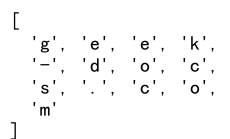JavaScript中的三个点
在JavaScript中,三个点(…)是一个很有用的操作符,它有多种用途,包括展开运算符、剩余参数和对象扩展。在本文中,我们将详细介绍JavaScript中三个点的用法,并提供示例代码来帮助读者更好地理解。
1. 展开运算符
展开运算符可以将一个数组或对象展开成独立的元素。这在函数调用、数组字面量和对象字面量中非常有用。
示例代码1:展开数组
const arr1 = [1, 2, 3];
const arr2 = [...arr1, 4, 5];
console.log(arr2); // [1, 2, 3, 4, 5]
Output:

示例代码2:展开对象
const obj1 = { name: 'Alice', age: 30 };
const obj2 = { ...obj1, city: 'New York' };
console.log(obj2); // { name: 'Alice', age: 30, city: 'New York' }
Output:

2. 剩余参数
剩余参数允许我们将不定数量的参数收集到一个数组中。这在函数定义中非常有用,可以处理不确定数量的参数。
示例代码3:剩余参数
function sum(...nums) {
return nums.reduce((acc, curr) => acc + curr, 0);
}
console.log(sum(1, 2, 3, 4, 5)); // 15
Output:

3. 对象扩展
对象扩展允许我们将一个对象的属性扩展到另一个对象中。这在对象合并和克隆中非常有用。
示例代码4:对象扩展
const obj1 = { name: 'Bob', age: 25 };
const obj2 = { ...obj1, city: 'Los Angeles' };
console.log(obj2); // { name: 'Bob', age: 25, city: 'Los Angeles' }
Output:

4. 结合使用
三个点还可以结合使用,实现更复杂的操作,比如合并数组、合并对象等。
示例代码5:合并数组
const arr1 = [1, 2, 3];
const arr2 = [4, 5, 6];
const mergedArr = [...arr1, ...arr2];
console.log(mergedArr); // [1, 2, 3, 4, 5, 6]
Output:

示例代码6:合并对象
const obj1 = { name: 'Alice', age: 30 };
const obj2 = { city: 'New York', job: 'Engineer' };
const mergedObj = { ...obj1, ...obj2 };
console.log(mergedObj); // { name: 'Alice', age: 30, city: 'New York', job: 'Engineer' }
Output:

5. 解构赋值
三个点还可以用于解构赋值,将数组或对象中的元素解构到变量中。
示例代码7:解构数组
const arr = [1, 2, 3];
const [first, ...rest] = arr;
console.log(first); // 1
console.log(rest); // [2, 3]
Output:

示例代码8:解构对象
const obj = { name: 'Bob', age: 25, city: 'Los Angeles' };
const { name, ...rest } = obj;
console.log(name); // 'Bob'
console.log(rest); // { age: 25, city: 'Los Angeles' }
Output:

6. 字符串扩展
三个点还可以用于字符串扩展,将字符串转换为字符数组。
示例代码9:字符串扩展
const str = 'geek-docs.com';
const charArray = [...str];
console.log(charArray); // ['g', 'e', 'e', 'k', '-', 'd', 'o', 'c', 's', '.', 'c', 'o', 'm']
Output:

7. 函数调用
三个点还可以用于函数调用,将数组中的元素作为参数传递给函数。
示例代码10:函数调用
function multiply(a, b, c) {
return a * b * c;
}
const nums = [2, 3, 4];
const result = multiply(...nums);
console.log(result); // 24
Output:

8. 数组拷贝
三个点还可以用于数组的浅拷贝,创建一个新的数组,而不是引用原数组。
示例代码11:数组拷贝
const arr1 = [1, 2, 3];
const arr2 = [...arr1];
arr2.push(4);
console.log(arr1); // [1, 2, 3]
console.log(arr2); // [1, 2, 3, 4]
Output:

9. 对象拷贝
三个点还可以用于对象的浅拷贝,创建一个新的对象,而不是引用原对象。
示例代码12:对象拷贝
const obj1 = { name: 'Alice', age: 30 };
const obj2 = { ...obj1 };
obj2.city = 'New York';
console.log(obj1); // { name: 'Alice', age: 30 }
console.log(obj2); // { name: 'Alice', age: 30, city: 'New York' }
Output:

10. 合并对象
三个点还可以用于合并对象,将多个对象合并成一个新的对象。
示例代码13:合并对象
const obj1 = { name: 'Alice', age: 30 };
const obj2 = { city: 'New York', job: 'Engineer' };
const mergedObj = { ...obj1, ...obj2 };
console.log(mergedObj); // { name: 'Alice', age: 30, city: 'New York', job: 'Engineer' }
Output:

11. 函数参数
三个点还可以用于函数参数,将不定数量的参数收集到一个数组中。
示例代码14:函数参数
function sum(...nums) {
return nums.reduce((acc, curr) => acc + curr, 0);
}
console.log(sum(1, 2, 3, 4, 5)); // 15
Output:

12. 字符串连接
三个点还可以用于字符串连接,将多个字符串连接成一个新的字符串。
示例代码15:字符串连接
const str1 = 'Hello, ';
const str2 = 'world!';
const combinedStr = [...str1, ...str2].join('');
console.log(combinedStr); // 'Hello, world!'
Output:

13. 数组合并
三个点还可以用于数组合并,将多个数组合并成一个新的数组。
示例代码16:数组合并
const arr1 = [1, 2, 3];
const arr2 = [4, 5, 6];
const mergedArr = [...arr1, ...arr2];
console.log(mergedArr); // [1, 2, 3, 4, 5, 6]
Output:

14. 对象合并
三个点还可以用于对象合并,将多个对象合并成一个新的对象。
示例代码17:对象合并
const obj1 = { name: 'Alice', age: 30 };
const obj2 = { city: 'New York', job: 'Engineer' };
const mergedObj = { ...obj1, ...obj2 };
console.log(mergedObj); // { name: 'Alice', age: 30, city: 'New York', job: 'Engineer' }
Output:

15. 数组解构
三个点还可以用于数组解构,将数组中的元素解构到变量中。
示例代码18:数组解构
const arr = [1, 2, 3];
const [first, ...rest] = arr;
console.log(first); // 1
console.log(rest); // [2, 3]
Output:

16. 对象解构
三个点还可以用于对象解构,将对象中的属性解构到变量中。
示例代码19:对象解构
const obj = { name: 'Bob', age: 25, city: 'Los Angeles' };
const { name, ...rest } = obj;
console.log(name); // 'Bob'
console.log(rest); // { age: 25, city: 'Los Angeles' }
Output:

 极客教程
极客教程